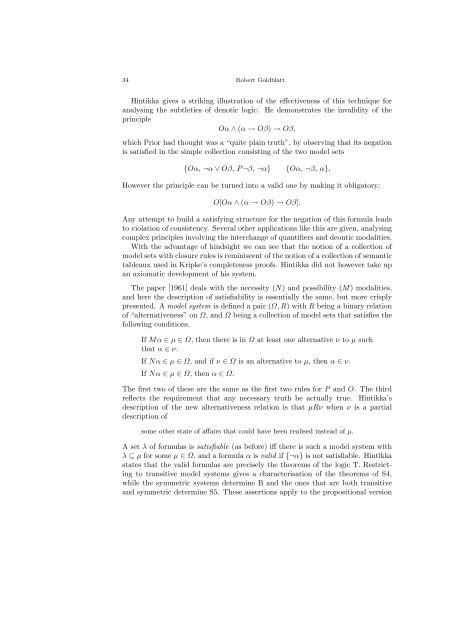MATHEMATICAL MODAL LOGIC: A VIEW OF ITS EVOLUTION
MATHEMATICAL MODAL LOGIC: A VIEW OF ITS EVOLUTION
MATHEMATICAL MODAL LOGIC: A VIEW OF ITS EVOLUTION
Create successful ePaper yourself
Turn your PDF publications into a flip-book with our unique Google optimized e-Paper software.
34 Robert GoldblattHintikka gives a striking illustration of the effectiveness of this technique foranalysing the subtleties of denotic logic. He demonstrates the invalidity of theprincipleOα ∧ (α → Oβ) → Oβ,which Prior had thought was a “quite plain truth”, by observing that its negationis satisfied in the simple collection consisting of the two model sets{Oα, ¬α ∨ Oβ, P ¬β, ¬α}{Oα, ¬β, α}.However the principle can be turned into a valid one by making it obligatory:O[Oα ∧ (α → Oβ) → Oβ].Any attempt to build a satisfying structure for the negation of this formula leadsto violation of consistency. Several other applications like this are given, analysingcomplex principles involving the interchange of quantifiers and deontic modalities.With the advantage of hindsight we can see that the notion of a collection ofmodel sets with closure rules is reminiscent of the notion of a collection of semantictableaux used in Kripke’s completeness proofs. Hintikka did not however take upan axiomatic development of his system.The paper [1961] deals with the necessity (N) and possibility (M) modalities,and here the description of satisfiability is essentially the same, but more crisplypresented. A model system is defined a pair (Ω, R) with R being a binary relationof “alternativeness” on Ω, and Ω being a collection of model sets that satisfies thefollowing conditions.If Mα ∈ µ ∈ Ω, then there is in Ω at least one alternative ν to µ suchthat α ∈ ν.If Nα ∈ µ ∈ Ω, and if ν ∈ Ω is an alternative to µ, then α ∈ ν.If Nα ∈ µ ∈ Ω, then α ∈ Ω.The first two of these are the same as the first two rules for P and O. The thirdreflects the requirement that any necessary truth be actually true. Hintikka’sdescription of the new alternativeness relation is that µRν when ν is a partialdescription ofsome other state of affairs that could have been realised instead of µ.A set λ of formulas is satisfiable (as before) iff there is such a model system withλ ⊆ µ for some µ ∈ Ω, and a formula α is valid if {¬α} is not satisfiable. Hintikkastates that the valid formulas are precisely the theorems of the logic T. Restrictingto transitive model systems gives a characterisation of the theorems of S4,while the symmetric systems determine B and the ones that are both transitiveand symmetric determine S5. These assertions apply to the propositional version
















